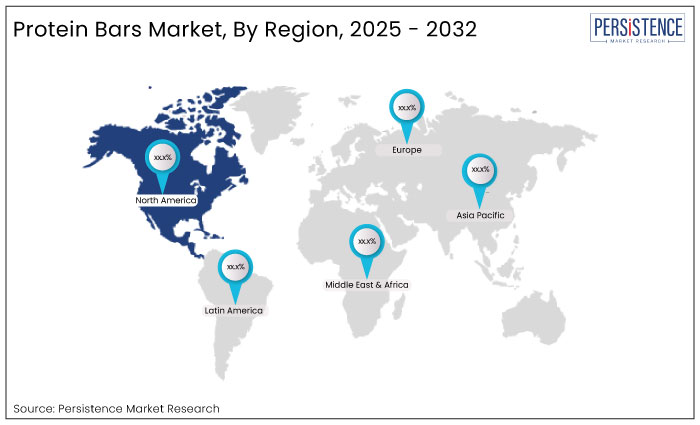ID: PMRREP18604| 187 Pages | 10 Mar 2025 | Format: PDF, Excel, PPT* | Food and Beverages

The Global Protein Bar Market is anticipated to be valued at US$ 8,289.8 Mn by the end of 2032, up from US$ 5,453.8 Mn in 2025. Furthermore, the market is projected to witness a notable CAGR of 6.2% from 2025 to 2032.
Persistence Market Research anticipates that evolving nutrition trends and snacking habits are influencing product development and market expansion. Future growth is expected to be influenced by sustainability efforts, tailored nutrition, and wide accessibility through e-commerce.

Key Highlights of the Market
|
Attributes |
Key Insights |
|
Market Size (2025E) |
US$ 5,453.8 Mn |
|
Projected Market Value (2032F) |
US$ 8,289.8 Mn |
|
Forecast Growth Rate (CAGR 2025 to 2032) |
6.2% |
|
Historical Growth Rate (CAGR 2019 to 2023) |
5.0% |
The growth of convenient, on-the-go snack formats such as protein bars is attributed to the U.S. Busy consumer lifestyles in the U.S. drive demand for convenience items in the food and beverage industry, and protein bars have been a major beneficiary of this trend.
Today, the global protein bars market is thriving at a noteworthy pace. The growth of the market is driven predominantly by rising health consciousness, busy work schedules, and the expansion of an enthusiastic population that keenly seeks protein-rich diet options for muscle building.
The market has grown much beyond basic nutrition bars. Flavor innovations, textural variations, and functionalities are the major highlights shaping the industry. Protein bars are typically popular among athletes, low-sugar options trend among diabetics or health nuts, and specialized varieties are gradually penetrating the vegan and keto clusters.
The market for protein bars is growing remarkably versatile, covering all industry trends, and will continue to be the best growth accelerator in the long run.
The protein bars market appears to have enjoyed a period of steady growth between 2019 and 2024. The sales surge during this period was linked to healthy eating habits, suggesting a continuation of this positive trend. A strong focus on health and well-being likely fueled market growth throughout this period. Consumers increasingly sought convenient and portable protein sources to support their busy lifestyles and increased immunity needs. It is anticipated that a change in snacking preferences, with protein bars taking the place of less healthful options like chips, will further accelerate this trend.
The COVID-19 pandemic’s impact on the protein bars market seems to be a double-edged sword. The focus on immunity during the pandemic pushed consumers towards protein bars perceived to boost the immune system. Additionally, supply chain disruptions for some unhealthy snacks made protein bars a more readily available alternative.
During the forecast period, the market is expected to retain its growth trajectory. The increasing emphasis on health and convenience, together with the constant development of unique protein bar varieties that cater to a variety of dietary demands, paints a bright future for this business.
Growing Consumer Preference for Nutritious and On-the-Go Protein Solutions
The global market for protein bars is expanding primarily due to the growing need for quick, healthful snack options. The market outlook for 2024 indicates that protein bar sales are expected to continue to rise due to busy lives and a notable increase in health consciousness.
As per a Mondel?z International, 91% of global consumers have one snack per day.
This highlights the increasing demand for convenient and health-focused snack options like protein bars. Protein bars are becoming more and more popular as a convenient, portable source of minerals and protein that promotes weight loss, muscle growth, and general health. In the upcoming years, this consumer attitude will primarily support market expansion.
Growing Popularity of Plant-Based and Alternative Protein Sources
The market for protein bars is expanding due in large part to the growing popularity of plant-based diets. Customers are increasingly choosing plant-based and alternative protein sources, such as pea, rice, hemp, and soy protein, over animal-derived proteins. Environmental sustainability, ethical considerations, and health consciousness are driving this change.
As a reflection of the global shift to plant-based living, 700,000 people from 228 countries joined the Veganuary campaign in January 2023. Plant-based protein bars are becoming more and more popular as more people experiment with vegetarian, vegan, and flexitarian diets.
This movement is further supported by the growing number of functional and fortified plant-based bars that appeal to consumers who are health-conscious and fitness fanatics. Plant-based protein bars are establishing themselves as a mainstay in the healthy snacking market as consumer tastes change, boosting their long-term prospects.
Short Shelf Life of Novel Protein Bars
As consumer desire for natural, minimally processed, and preservative-free protein bars increases, brands must find ways to keep their products fresh without resorting to chemical ingredients. High-moisture components like nut butters, dried fruits, and plant-based proteins are found in many clean-label protein bars, which can cause texture deterioration and spoil more quickly over time.
According to a survey report from Synergy, a global manufacturer and supplier of flavorings, extracts, and essences, 50% of bars experience hardening issues within three months of the product's release.
This limitation is especially troublesome for international exports and e-commerce, where goods must stay fresh for extended storage and delivery times. In the absence of efficient natural preservation methods, businesses run the danger of losing clients who want protein bars with longer shelf lives.
Innovations in Sustainable and Eco-Friendly Packaging
Consumers are increasingly concerned about plastic waste and environmental impact, driving companies to choose packaging materials that are recyclable, compostable, and biodegradable. To lower their carbon footprint, many protein bar companies are looking into plant-based packaging options, such as paper-based substitutes, seaweed-based wraps, and bioplastics derived from cornstarch.
One prominent example is Clif Bar, a Mondelez International brand that has planned to have all of its packaging recyclable, reused, or compostable. Additionally, they are going to avoid and eliminate up to one million pounds of plastic trash from the environment by 2025.
High Protein Bars Lead the Charge
The demand for protein bars is a reflection of people's increasing interest in fitness and health. This market sector is unquestionably leading since consumers are choosing bars with the highest protein content (over 25g).
Medium protein bars (16–25g) that appeal to those who are generally health-conscious come next, followed by low protein bars (0–15g) that might be appropriate for snacking or for people with certain dietary requirements.
Growing Consumer Preference For Plant-based Diets Has Gained Traction.
The protein bar market is rapidly shifting toward plant-based protein as customers look for more nutritious, cleaner, and ethical alternatives to animal-based proteins. The surge in veganism, flexitarian diets, and lactose intolerance has increased demand for plant-based protein sources such as pea, rice, hemp, and soy protein.
Animal protein currently reigns supreme due to its wider availability, and lower production costs. However, the tide is turning. Despite the higher extraction costs associated with plant-based protein sources, this segment is poised for significant future growth.
As per National Research Council Canada, more than 40% of the population in Canada is actively trying to incorporate more plant-based foods into their diets. Their compatibility with vegetarian, vegan, and “flexitarian” lifestyles is now putting the spotlight on plant-based protein sources.
North America Dominates the Protein Bar Market
North America continues to lead the worldwide protein bar industry. This region's domination originates from an increasing number of health-conscious consumers in the U.S. and Canada, a growing desire for healthy food options, and the popular on-the-go snacking trend.
The strong emphasis on fitness among North American consumers, combined with the carefully developed healthy lifestyle trend, drives the region's market forecast. The acceptance of protein bars and related products as a handy and nutritious snack will keep the region as the leading market in this category.
Furthermore, well-developed retail channels, significant attempts to build brand visibility, and consumers' busier on-the-go lifestyles are projected to add to North America's dominant position in the worldwide protein bar market.

The South Asia and Oceania Region Is Witnessing A Surge In Protein Bar Consumption
The South Asia and Oceania region is expected to be the fastest-growing protein bar market due to increasing standards of living, rising expenditure on lifestyle and diet, and increased awareness and availability of health and wellness products. Pacing urbanization, busy lives similar to those found in Western developed nations, and growing F&B trends together contribute to the region's continued rise.
Plant-based protein bars, which are made from some of the most popular, indigenous sources such as rice protein, pea protein, and hemp protein, constitute another strong trend affecting market performance in the South Asia and Oceania region.
|
Report Attributes |
Details |
|
Historical Data/Actuals |
2019 – 2024 |
|
Forecast Period |
2025 – 2032 |
|
Market Analysis |
Value: US$ Bn |
|
Geographical Coverage |
|
|
Segmental Coverage |
|
|
Competitive Analysis |
|
|
Report Highlights |
|
|
Customization and Pricing |
Available upon request |
By Product Type
By Protein Source
By Protein Content
By Distribution Channel
By Region
Delivery Timelines
For more information on this report and its delivery timelines please get in touch with our sales team.
About Author